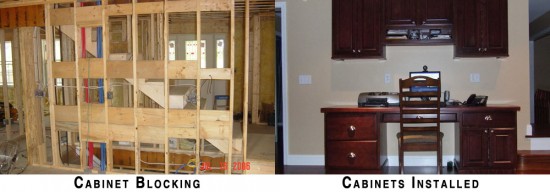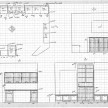Cabinet Blocking Inside Wall Framing
Cabinet Blocking

I’m often reminded that I should write articles about even the simplest details as what I might take for granted is not so obvious to all readers. If you’re building a new home or remodeling an existing one where cabinet installation is involved then you should pay attention to cabinet blocking. Installing cabinets is MUCH easier when the wall framing contains solid wood blocking. The wood blocking allows you to screw the cabinet “boxes” to the wall easily and it ensure a very secure strong installation.
Standard Blocking Heights
The location of solid wood blocking depends on the type of cabinets that you’re installing. However, there are some fairly basic standard dimensions that will cover most applications. Most base cabinets range in height from 30 inches (bathroom vanities and office desks) to 36 inches (kitchen cabinets). The key is to install the top of the blocking at the top of cabinet or the bottom of blocking at the bottom of cabinet.
Blocking Material
We like to use scrap framing lumber for our blocking, obviously it’s a great way to reduce waste and keep material out of the landfill. At a minimum you’ll want to use a 2×6 and preferably a 2×8 or more. Even if you’ve framed the walls with metal studs you can use the same materials for blocking. If there’s a really long run of cabinets you can install a layer of plywood instead of the drywall. I did this in our first home when I remodeled the kitchen and it worked great. I ran a layer of 1/2 inch thick plywood behind the entire length of base cabinets instead of the drywall.
Install Nail Plates
One thing you won’t see in the photo above are nail plates. That’s not because they didn’t get installed, the photo was just taken before the plumbing and electrician had installed them. If you’re going to install wood blocking be sure to include nail plates to cover any plumbing or electrical that might be behind it. Sometimes blocking gives us a false sense of security that could lead to a screw through a pipe or wire!
Other Blocking Locations
Blocking isn’t just important for cabinets. Blocking should be installed in as many locations as possible for things like bathroom accessories (towel bars and paper holders), stair handrails, television support brackets, heavy artwork, chair rails, crown moulding and any other place that you’ll be fastening items to in the future. Installing it while the walls are open will save so much time in the future and it’s cheap and easy to do.

















Todd,
All great points… also don’t forget in stairways and the bathroom for grab bars. I’m seeing this more and more as older Americans are opoting to remodel and stay in their homes.
You’re so right about the tiny details that we overlook!
Especially in the bathroom! Grab Bars are becoming more commonplace and require substantial fastening.
Towel bars get more abuse than just about any other bit attached to walls. Don’t get me started on the sizes and centers on towel bars vs framing spacing.
http://www.lemurzone.com/rfg/index.php/2009/06/19/lightyear-sunken-bath-episode-8-blocking/
I have to disagree with you on the plywood vs drywall from a fire safety standpoint. Sheeting walls with plywood is a great idea, but not leaving it exposed, especially in a kitchen where fire is a greater risk than any other area of your home. Sheet the wall in ply but cover it with drywall.
Other locations to consider are blocking the spaces on either side of large windows, for attaching draperies, walls in mud rooms where you have coat racks.
For walls that are not going to be opened cleating is an option as well.
http://www.lemurzone.com/rfg/index.php/2008/10/10/a-cabinet-hanging-solution/
Alan – I never suggested leaving exposed plywood, the cabinets are installed over them.
I currently live in Europe where many in the building industry are NOT big fans of drywall and prefer to use cinder-block for interior wall construction. We recently renovated our flat but decided to go with drywall instead of cinder block mainly because of costs. Our contractor used metal framing instead of wood throughout the project.
The carpenter we have chosen to do our kitchen does beautiful work but dislikes drywall installation because of weight issues. He wants us to sign a disclaimer before he starts work which clears him of liability should the upper cabinets come crashing down. I’ve been researching kitchen installations into metal framing and the reviews have not been good so we’ve become quite concerned especially since we have 2 rows of upper cabinet (92 cm & 42 cm). I’ve read ripping up the newly installed and painted drywall and installing wood blocking would provide the much needed support that is needed for the upper cabinets, however, ripping up the whole wall would be very expensive and labor intensive. My question is how can it be done in cost effective manner and how do I explain this to the carpenter or better yet show him with pictures/video (language issues)??
Stats/Dimensions:
Wall length: 3.36m
Wall: metal frame with 2 layers of drywall
Support beams on both sides of the wall: brick or cinder block very thick
Any help, suggestions, VISUALS, etc would be greatly appreciated!
Antilla – How thick are the two layers of drywall? Do the cabinets reach up to the ceiling? Do the cabinets extend to each side wall?
Todd thanks for getting back to me!
Each layer of drywall is .5 inch thick. The cabinets will be run wall to wall with both upper and lower cabinets. Due to strict laws regarding gas lines here, we can not cover our gas line which runs close to the ceiling, therefor the top of the cabinets stop about 13 cm below the ceiling.
From left to right:
1. 40 cm high/80 cm wide 2 door cabinets sitting on top of 92cm high/80 cm 2 door cabinets with glass doors
2. Next comes a side by side fridge which is framed with large 65 cm high by 91 cm wide cabinet on top (same dept as the fridge so it appears built in.
3. Next 40 cm high/48cm wide single door cabinet sitting on top of 92cm high/48 cm single door cabinet
4. Next is the ventilation system that is hidden by a 78X60 sitting on top of a 35×60 cabinet
5. Finally, Next 40 cm high/48cm wide single door cabinet sitting on top of 92cm high/48 cm single door cabinet
All the cabinets have a 37 cm dept. I know there is waaaay too much info here but there was no way for me to attach the kitchen plans to give you a better idea. Again, thank you in advance for your help!!
A – I just emailed you, if you can email me the plans I’ll take a look.
I have a question please on the blocking. My contractor has installed a suspended cabinet (18×24)in the bathroom (actually kitchen uppers). When I apply pressure (a fair amount) on the front up and down the unit actually moves. It appears it is the blocking itself (wall is still open) that is moving. The contractor says this is fine as the weight is not totally at the front and the unit will support the marble top and sink just fine. I am feeling a little worried that it may not be enough support. Can anyone provide your insight on this – i.e. does it need more support in the wall? Thank you.
Alena – Can you be more specific about what’s going on or even better do you have a photo? If you have a photo you can email it to: todd “at” frontstepsmedia “dot” com
Thanks Todd! I just sent the pictures to your e-mail.
We had a new house built in 2008. I talked to the job superintendent and asked him to install blocking in the kitchen for the cabinets. He asked me why, and I told him that when I framed houses that’s what we did and I would like it done in mine. During me pre-drywall walk through I had not seen any blocking and he stated that they were unable to put any blocking in, it was just too late.
The builder was Freedom Homes, we live in Northern Kentucky and the builder in late 2008 stopped building in our area.
Sorry to hear that Darell. Clearly your builder was not very reputable nor was he very professional. Blocking is absolutely necessary and what I consider minimum building practice. We are starting to frame kitchens with engineered lumber now for straighter walls, not really strength but we like to do things of the best possible quality.
At what height should I put the blocks for the upper kitchen cabinets?
Keith – You’ll need two rows of blocking. One should be located so the center of blocking is 18″ above the base cabinets or 54″ above the floor. The upper row of blocking depends on the height of your upper cabinets. Upper cabinets come in several heights so it depends on that.
So center of lower blocking is 18″ above base cabinets, would that make the center aligning with the bottom of the cabinets? And if so, would the upper row of blocking then center with the tops of the cabinets? If not then what is the rule of thumb on how far down from the cabinet tops should the upper row of blocking be centered?
Logan – You are correct. Typically blocking is installed based on the cabinet heights. Lower cabinets are typically 34-1/2″ tall, so a row or blocking is placed there. Then a 2nd row of blocking is placed 18″ above that row for the bottom edge of the upper cabinets. Then a third row of blocking is installed where the top of the cabinets fall. If you have 36″ tall upper cabinets then the third row would be centered 36″ above the 2nd row.
what is the cost per linear.ft. of cabinets blocking in sheetrock walls?
Are you asking how much it costs to install blocking in a wall? Really only the cost of the wood and some minimal labor.
I want to install wood blocking behind an already existing sheetrocked (finished) wall, any advice on the best way, thx
Only way I know is cutting out the drywall, installing the blocking, and re-installing the drywall.
Todd,
I plan on building a tiny home on a 30 foot flatbed trailer. I have some exp. dry walling and limited framing experience, and these articles are extremely helpful. I have an electrician friend to work with, and I will have a plumber inspect all final plumbing. Is there some way to hire someone to occasionally inspect your progress and advise you without using them full-time? I hope to use this as a first effort and sell it, and then build a tiny house of my own as a lake cabin I can move to different family lake cabins i.e.. kids and siblings.
Mark
Mark – Get to know your local building inspector…they are a wealth of knowledge and likely will help a great deal during inspections.
Great article!, If looking for blocking to be used with metal studs, are there easily bought 16 on center blocking systems to buy, Z clips with pre cut 2 by 6’s with the rabbits cut to fit into stud? what should I ask for at the local lowes or home depot? Thank You again.
Hi Todd.
Installing kitchen on new construction with visible studs. The kitchen will run wall to wall, cabinets on bottom, cabinets on top, tile in between. can I just plywood the entire wall? will that work as blocking for the cabinets and a tile backing?
thank you
RJ
I would just plywood the lower 28″ (for lower cabinets), then a strip of drywall from 28″ up to the a couple inches above the bottom of your uppers, then plywood above that.
Thanks Todd ! You were very helpful and to the point.